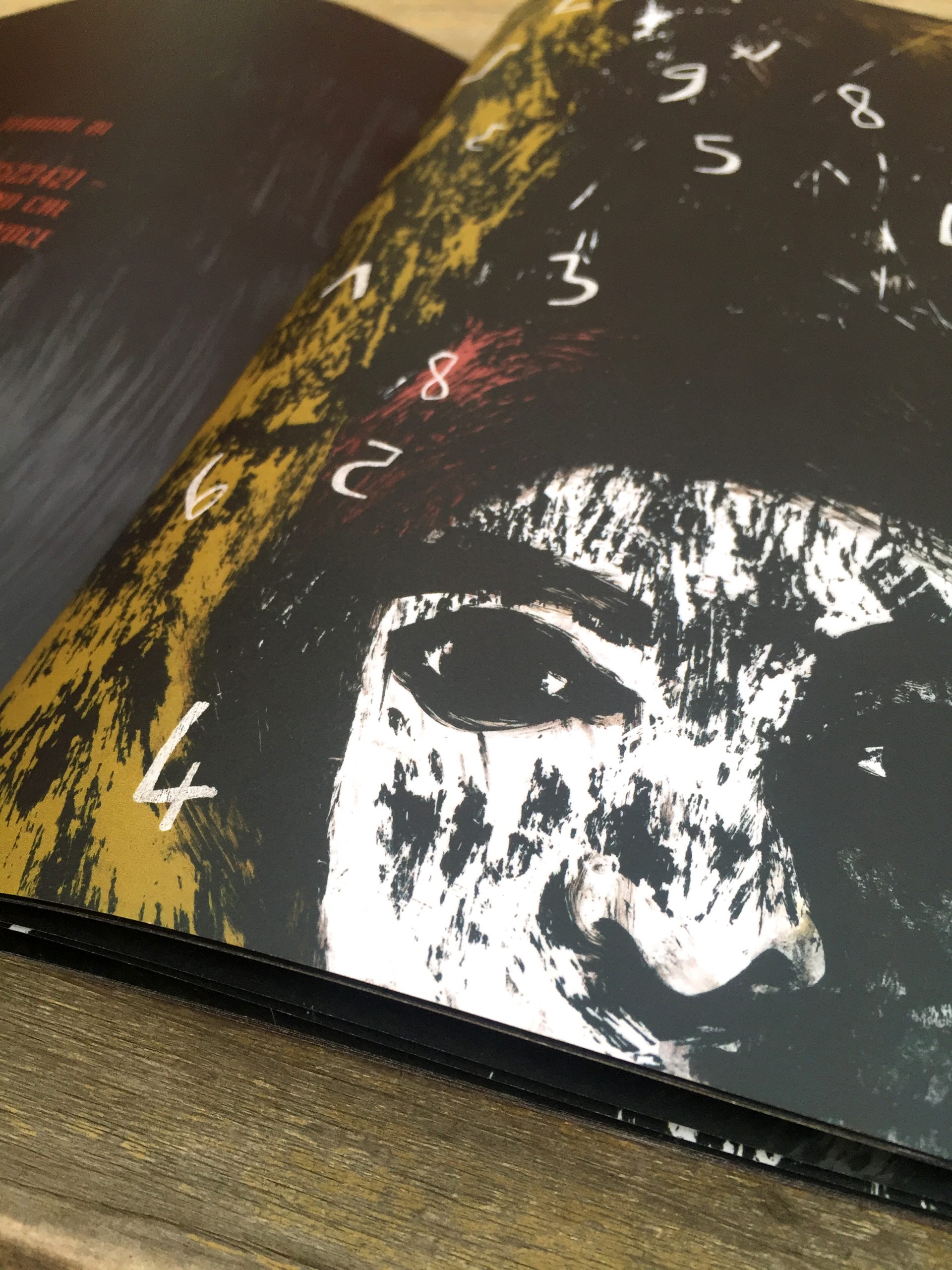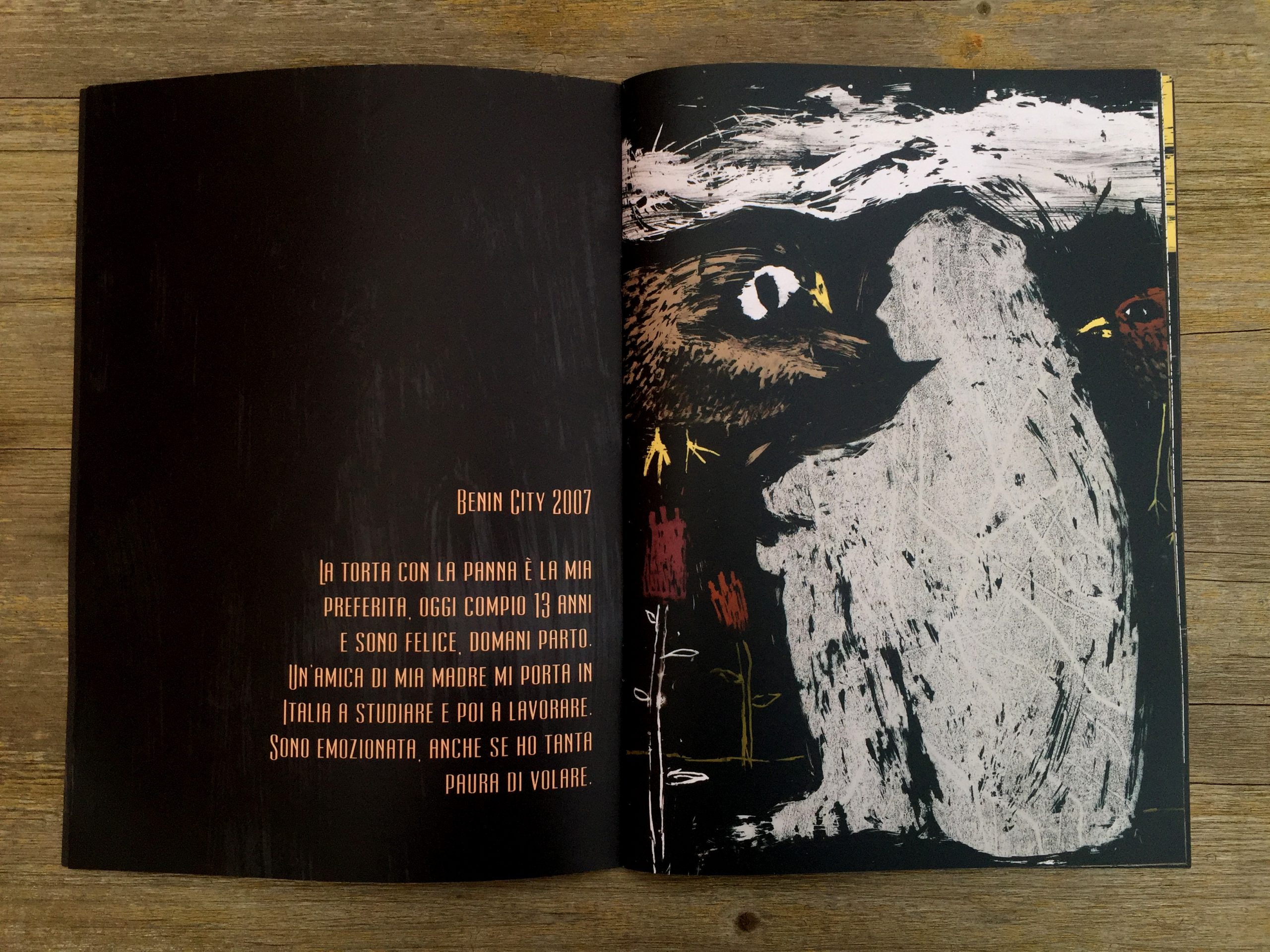Faith is 13 years old. She doesn’t yet know what the future has in store for her across the sea. She’s scared and finds no comfort during her voyage. Nevertheless she decides to believe and trust in people, even after so much suffering.
Though the name, Faith, is imaginary, the story illustrated is true. A young girl places her trust in the wrong person and becomes a victim of human trafficking. Looking through the bars where she is held captive in the Sahara Desert – one of the many places victims of human trafficking are imprisoned while awaiting passage – she finally come to the realisation she will not be going to Italy to study. Crossing the Mediterranean sea by boat, her eyes are vacant: probably the idea of letting go, of disappearing in the vastness of the sea crossed her mind at least once.
Faith is a story about pain, suffering and about hope. It recounts the tale of a young girl leaving Nigeria in hopes for a better life, better prospects, who ends up victim of human traffickers. The story is based on true events. It is like so many other stories: fragile and invisible lives of countless victims, mostly ignored, which never make the headlines and are never told. This project, created by Rossana Calbi with Strange Opera Association, was inaugurated March 7 at the Inferno Store in Rome. The exhibit is currently closed due to COVID-19, but the book (published in limited edition) will take you through this arduous, terrible journey. It will make you reflect on this important topic, which is rarely spoken of.

FAITH – by Andreina Bochicchio and Marta Bianchi, curated by Rossana Calbi
Who are the victims of human trafficking?
It’s quite common for people to confuse human trafficking victims with migration, even though the two are completely different phenomena. As stated in a UNHCR document supporting Territorial Commissions to recognise victims of human trafficking, “The issue of trafficking has attracted substantial attention in recent years, but it is not a modern phenomenon. (…). Trafficking in the context of the sex trade is well documented and primarily affects women and children who are forced into prostitution and other forms of sexual exploitation. Trafficking is not, however, limited to the sex trade or to women. It also includes, at a minimum, forced labour or services, slavery or practices similar to slavery, servitude or the removal of organs [1]”.
The same document states that, “…since 2005 Nigeria is one of the countries with the most elevated number of crossing, most of these people are women, who come to Italy after they have been recruited by criminal organizations who then put them to work in prostitution rings.” Women are only a part of the human trafficking ring, which “includes a wide range of victims, from various countries trafficked for various exploitation purposes. Women, men and LGBTQI victims also come from Eastern Europe, the People’s Republic of Cina, Central and South America to be exploited as sexual workers or enforced labour. A grave and serious problem has also become the trafficking of people for the illegal transplant of organs [2]”.

FAITH – by Andreina Bochicchio and Marta Bianchi, curated by Rossana Calbi
Rossana Calbi’s Project
To tell these victims’ stories it’s essential to know the dynamics of the journeys they take as well as the psychological impact they have on the victims. For this reason the project curated by Rossana Calbi is in collaboration with Andreina Bochicchio, lawyer specialized in asylum and immigration rights as well as expert in identifying, assisting and protecting human trafficking victims, and illustrator Marta Bianchi, freelance illustrator and psychologist based in Rome.
Faith is one story and a thousand stories all together. It narrates the tale of a girl victim of trafficking. It describes the characteristics of many similar stories that, for various tragical reasons, have no voice and are never told. It helps remind us that this 13 year old girl could be our daughter, our niece, our friend. It reminds us that there are thousands of people who, everyday, cross borders and frontiers, following the paths traced by criminal organizations whose only purpose is that of making money (by exploiting their victims).
Countless victims arrive on Italian shores daily, they choose it as their place of destination or simply a means of passage to continue their journey further north. They arrive tired, weary of the atrocities they encountered on their voyage over, and subdued by the criminals who imposed silence on them, who exercised both physical and psychological violence on them. Faith’s story reminds us that we should pay more attention to the numberless victims, like Faith, who arrive daily on our shores. And we should learn to look and to listen to these victims we are so used to observe through a glass on indifference.

FAITH – by Andreina Bochicchio and Marta Bianchi, curated by Rossana Calbi
Marta Bianchi, illustrator of Faith’s story, transformed the little girls emotions, feelings, thought to pictures. Not worrying about being too obscure or creating discomfort, she used a decisive and audacious hand to design these images. Andreina Bocchicchio, who gives voice to the little girl, does so while maintaining a truth to Faith’s thoughts, avoiding elements which could help narrate the story but which would be irrelevant to a girl, alone, in the middle of the sea. So the illustrations are accompanied, exclusively, by the thoughts that inundate the girls mind, by her emotions, her fears. They tell of the turmoils, of the silence, of the violence, of the suffering afflicting these victims. Not only Faith but also countless other men, women and children.
[1] L’identificazione delle vittime di tratta tra i richiedenti protezione internazionale e procedure di referral. Linee Guida per le Commissioni Territoriali per il riconoscimento della protezione internazionale, by the National Commission on Asylum and the High Commission for Refugees – UNHCR, 2017, pp. 7-8. [2] L’identificazione delle vittime di tratta tra i richiedenti protezione internazionale e procedure di referral. Linee Guida per le Commissioni Territoriali per il riconoscimento della protezione internazionale, by the National Commission on Asylum and the High Commission for Refugees – UNHCR, 2017, p. 9.
You can order the book by contacting Inferno Store. To know more about the project, visit the @strange_opera profile. Marta Bianchi‘s images can also be found on her Instagram page @martabianchiilustrator.
The UNHCR document cited above is found at the following links:
English (Guidelines on International Protection) here.
Italian (L’identificazione delle vittime di tratta tra I richiedenti protezione internazionale e procedure di Referral) qui.
Translation by Ludovica Sarti
Read other Curiosità on ZìrArtmag
